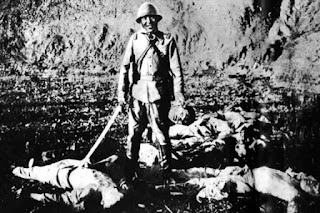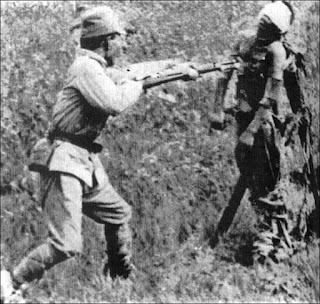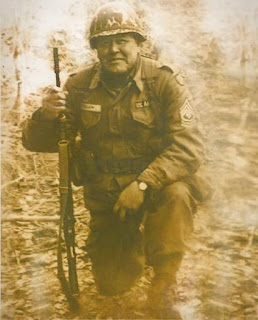WHY WERE THE JAPANESE SO CRUEL IN WORLD WAR II?
Before and during World War II, Japanese forces murdered millions of civilians and prisoners of war. Why?
On Feb. 16, 1942, Japanese troops herded 23 Australian women into the surf from a beach on Bangka Island in the Dutch East Indies (present-day Indonesia). All but one of the women were army nurses, captured after Japanese bombers sank the ship on which they were attempting escape from Singapore.
The nurses wore uniforms clearly emblazoned with the Red Cross. When the captives reached waist-deep water, machine-gun fire echoed across the beach ad jungle-covered hills. Screams and splashing accompanied the bursts of gunfire. Then, as abruptly, the firing stopped, and the beach fell silent. Miraculously, one of the nurses was still alive. Wounded in the torso, 26-year-old Vivian Bullwinkel floated in the sea, her head tilted to one side to gulp air as the surf pushed her gently toward the beach.
Minutes earlier the Japanese soldiers had murdered dozens of wounded Allied troops—the very patients Bullwinkel and her fellow nurses had been tending before their ship was blown from under them. Marching the wounded from the beach out of sight around a headland, the Japanese strode from patient to patient, another survivor later recalled, shooting some and driving their long bayonets deep into others. Returning to the beach, the murderers wiped their bayonets clean of blood before turning their attention to the nurses.
Wherever Japanese soldiers deployed during the 1930s and 1940s, they perpetrated barbaric—and well-documented—crimes against humanity. Examples are legion: widespread massacres of Chinese civilians in places like Nanking; the gang rape and murder of captured British and Chinese nurses following the fall of Hong Kong; the murder of Dutch and Indonesian civilians and wounded Allied prisoners throughout the Dutch East Indies; the machine-gunning of Allied sailors who survived the sinking of their ships; the beheadings of downed Allied airmen; and the thousands of British, Australian, Dutch and American prisoners who perished during forced labor in steaming Southeast Asian jungles or in mines in Japan and Korea. A telling statistic: While just 4 percent of Allied prisoners in German hands perished during the war, 27 percent of those captured by the Japanese died. On an even larger scale, the total number of civilians and prisoners murdered by the Japanese from the 1937 invasion of China through the end of World War II has been estimated to be as high as 20 million.
Such grim statistics beg questions: Why was the Japanese military so deliberately brutal toward defeated enemies and the civilian populations of conquered lands? What were the causes of such behavior? Can we ever understand why they committed crimes that go so far beyond generally accepted military conduct?
Japan’s wartime barbarism had its roots in the nation’s feudal history. From the early 17th century until the 1868 Meiji Restoration, a hereditary military dictatorship known as the Tokugawa shogunate ruled Japan, isolating it from the rest of the world. For more than two centuries the samurai—a class of military nobility whose bushido (“way of the warrior”) code demanded rigid loyalty to their liege lord and suicidal bravery in battle—governed society, demanding and receiving their subjects’ unquestioning obedience.
After the opening of Japan to Western commerce in the 1850s, the threat of subjugation by the technologically advanced Western powers exposed Japan’s inherent military and economic backwardness. Progressive samurai moved to restore imperial rule and, at the same time, modernize Japan’s industry and military. With the restoration of Emperor Meiji as a constitutional monarch, the military loyalty of most samurai shifted from the shogun to the emperor, making him a focus of national veneration. Japan’s victory in the First Sino-Japanese War (1894–95) and stunning defeat of Tsarist Russia (1904–05) marked Japan’s emergence as a significant military power and confirmed in Japanese minds the nation’s right to build an overseas empire in Asia.
Japan initially maintained friendly relations with the West—particularly with Britain, which had done much through treaties to help Japan create a world-class navy. But after World War I Japanese thinkers, seeing racism in the attitudes of the Western powers, disparaged the League of Nations, which existed, in the words of leading nationalist scholar Shumei Okawa, “[to] preserve the status quo and further the domination of the world by the Anglo-Saxons.” Okawa argued that “Japan would strive to fulfill her predestined role of champion of Asia.”
Military success and imperial expansion at home bred jingoism and xenophobia, prompting various theorists to link the “racial superiority” of the Japanese to the perceived superiority of the imperial dynasty. In 1890 the emperor had been declared divine, a direct descendant of the sun goddess Amaterasu—an idea rigorously taught in schools throughout Japan well into the 20th century. Several generations of Japanese believed the emperor’s divinity demanded unquestioning obedience of not only him but also his representatives in the government and military.
Colonel Kingoro Hashimoto, a nationalist army leader instrumental in hatching the war in China in the 1930s, termed this blind obedience Kodo (“Way of the Emperor”), insisting, “It is necessary to have politics, economics, culture, national defense and everything else all focused on one being, the emperor.” Okawa, for his part, believed it Japan’s divine mission to rule the world.
The Japanese media reinforced the concepts of imperial divinity, racial superiority and the right to rule Asia among the populace. These ideas found especially willing disciples in the nation’s military forces. Their barbarism in China in 1931 and 1937—including the Rape of Nanking, in which soldiers raped 80,000 women and murdered some 300,000 citizens—demonstrated the pervasive racism of the Japanese toward their enemies.
In the early 20th century, Japan’s imperialist leaders desperately sought the acceptance of Western nations and an equal right to colonial expansion. They were to be frustrated in those goals, however, as the major Western powers saw the Japanese as only a slightly superior form of Asian, certainly not as equals. The resulting insecurity and anger contributed enormously to the flourishing of xenophobia, militarism and fascism during the 1920s and 1930s.
Japan’s rise concerned Britain, the United States and other Western nations, all of whom sought to maintain the status quo. The rapid growth of the Imperial Japanese Navy, the expansion of Tokyo’s influence in Manchuria and Japan’s avowed dislike of the Soviet Union threatened regional stability. Alarmed by these developments, the Western powers committed a fateful strategic error: By forcing Tokyo to accept the restrictive terms of the 1930 London Naval Treaty, Washington and London simply confirmed its belief the West was deliberately thwarting Japan’s destiny, simply because its people were Asian.
The treaty unleashed a deep-seated hostility toward the Western powers —particularly the United States—at all levels of Japanese society, thus providing radical elements inside the Japanese military an opportunity to seize control.
Japanese militarism in the early 20th century followed two strands, each of which heavily influenced the nation’s military behavior during World War II.
The Imperial Way faction, or Kodoha, comprised a loose grouping of military officers and philosophers and stemmed from the severe financial crisis that struck prosperous and industrious Japan in the 1920s. Social unrest among the urban working classes, and resulting flirtations with socialism and communism, deeply concerned the army’s senior leaders. They saw the nation’s industrialists as greedy and corrupt and themselves as the uncorrupted soul of Japan.
Led by army officer and philosopher General Sadao Araki, the Imperial Way sought to return Japan to a “golden age,” in which the samurai would rule unchallenged and the emperor would wield absolute power. Democracy, viewed as a corrupt Western import, would be abandoned in favor of totalitarian rule, an ideology influenced by fascist ideas from Europe.
The ideology strove to merge the emperor, the people and the land within a moral framework, an effort aided enormously by the fact the emperor was already considered a living god. Japan’s elevation to a “master race” through intense propaganda carried echoes of National Socialism. The Nazi slogan “Ein Volk, Ein Reich, Ein Führer” (“One People, One Nation, One Leader”) could have as comfortably fitted the Imperial Way ethos. This faction demanded war with the Soviet Union, which in the 1930s was perceived as the primary threat to Japan’s ambitions in Manchuria and China.
The Toseiha, or Control faction, the opposing strand of imperialist thought, included such subsequently notorious figures as General Hideki Tojo. Toseiha’s adherents believed in purifying national politics in the same way as Kodoha and also rejected democracy. But they believed that any future conflict would be a “total war” requiring the unification of the military and industry.
Though both ideologies sought to create a military state, each wanted to control how that state came into being, and they clashed violently through the 1930s, engineering two wars in China before Japan’s attack on Pearl Harbor. The Toseiha faction ultimately prevailed, pushing Japan into total war, but the Japanese officer corps had embraced the Imperial Way concepts of spiritual power and imperial mysticism. They disseminated a perverted version of the samurai bushido code among soldiers, including the belief that any form of surrender was deeply dishonorable, even the surrender of one’s enemies. Surrender, so went the thinking, rendered the enemy soldier a nonentity, and a (Japanese) victor could treat a nonentity worse than an animal.
Xenophobia, a frustrated desire to join the imperialist “club” dominated by the Western powers, plus perceived British and American racism coalesced in Japan with nationalist ideologies: racial superiority; domination of an “inferior” China as a holy war; a belief that Japan was destined to rule the world; a distorted bushido code; a young, disaffected officer corps seething with Imperial Way and Toseiha ideology; and the powerful message that the emperor was an infallible living god. All these elements blended in an ideological witch’s brew that had a direct bearing on the treatment of Japan’s enemies.
From Day 1 of basic training, Japanese military officers taught that the Chinese were blood enemies and an inferior race, and that Japan would one day rule the world. Instructors molded recruits into obedient tools of the officer corps through brutal training regimens that punished even the slightest transgressions with physical violence. Recruits were taught that their officers were infallible and that any order issued by a superior must be treated as an order given by the divine emperor himself—who, as a living god, was always correct, as were his subordinates.
It was those at the core of Japan’s military power, the general officers, who decided to brutalize prisoners of war, and who made conditions so despicable in the camps. Junior officers and soldiers went along with these crimes because they too believed the orders infallible and that the emperor wished them to commit such outrages. The generals knew that the culturally ingrained respect for authority, coupled with the fear of exclusion and loss of face, meant scant resistance when they ordered Japanese troops to carry out morally repugnant orders.
As Caucasians had dominated Asia before 1941, it was they, according to Japanese thinking, who had tried to subordinate the Japanese and who had refused to recognize Japan’s legitimate right to be a great power. Thus, from the Japanese point of view, World War II was literally a race war. When Tokyo’s initial victories in 1941 put the boot on the other foot, Japanese troops were quick to use it to stamp on the white man’s face. The widespread barbarity and cruelty practiced by Japanese forces were clearly indicative of that hatred and loathing —and perhaps a deep-seated inferiority complex—many Japanese soldiers harbored toward their white foes.
“By 1941 [the Japanese] were ready to take on the white world in war, and they truly did not care anymore what the white man thought of them,” wrote American author Gavan Dawes in his 1994 book Prisoners of the Japanese. “They had torn the Geneva Convention to pieces. White men could go to hell, and the Japanese would be the ones to send them there.”
During the war, several hundred thousand Allied soldiers surrendered to Japanese forces. At the fall of Singapore in February 1942 the heavily outnumbered Japanese were astounded when some 80,000 British, Indian, Malay and Australian troops laid down their arms and marched themselves into captivity. To young and idealistic Japanese soldiers who saw themselves as modern-day samurai, such mass surrender was all but unimaginable; better to die than accept such a fate. They neither cared for nor understood the Western soldiers’ acceptance of surrender or lack of shame attached to preserving life when fighting no longer served a purpose.
The Japanese officer corps labeled the Geneva Convention the “coward’s code” and branded Allied capitulation another Western mindset as corrupt and contemptible as democracy. “Remember your status as prisoners of war,” one Japanese camp commandant told his prisoners in 1942. “You have no rights. International law and the Geneva Convention are dead.”
Toseiha adherent Tojo, Japan’s prime minister and minister of war, was personally responsible for running POW camps, and his ideology manifested itself in his orders to camp commanders: “You must not allow [prisoners] to lie idle, doing nothing but eating freely, for even a single day. Their labor and technical skill should be fully utilized for the replenishment of production and contribution rendered toward the prosecution of the Greater East Asiatic War, for which no effort ought to be spared.”
The Japanese considered the treatment of prisoners a cultural rather than practical difference between East and West. “In Japan we have our own ideology concerning prisoners of war,” Tojo wrote, “which should naturally make their treatment more or less different from that in Europe and America.” Tojo even instructed camp commandants to harden their hearts and not be “obsessed with the mistaken idea of humanitarianism or swayed by personal feelings.”
“By 1941 [the Japanese] were ready to take on the white world in war, and they truly did not care anymore what the white man thought of them,” wrote American author Gavan Dawes in his 1994 book Prisoners of the Japanese. “They had torn the Geneva Convention to pieces. White men could go to hell, and the Japanese would be the ones to send them there.”
During the war, several hundred thousand Allied soldiers surrendered to Japanese forces. At the fall of Singapore in February 1942 the heavily outnumbered Japanese were astounded when some 80,000 British, Indian, Malay and Australian troops laid down their arms and marched themselves into captivity. To young and idealistic Japanese soldiers who saw themselves as modern-day samurai, such mass surrender was all but unimaginable; better to die than accept such a fate. They neither cared for nor understood the Western soldiers’ acceptance of surrender or lack of shame attached to preserving life when fighting no longer served a purpose.
The Japanese officer corps labeled the Geneva Convention the “coward’s code” and branded Allied capitulation another Western mindset as corrupt and contemptible as democracy. “Remember your status as prisoners of war,” one Japanese camp commandant told his prisoners in 1942. “You have no rights. International law and the Geneva Convention are dead.”
Toseiha adherent Tojo, Japan’s prime minister and minister of war, was personally responsible for running POW camps, and his ideology manifested itself in his orders to camp commanders: “You must not allow [prisoners] to lie idle, doing nothing but eating freely, for even a single day. Their labor and technical skill should be fully utilized for the replenishment of production and contribution rendered toward the prosecution of the Greater East Asiatic War, for which no effort ought to be spared.”
The Japanese considered the treatment of prisoners a cultural rather than practical difference between East and West. “In Japan we have our own ideology concerning prisoners of war,” Tojo wrote, “which should naturally make their treatment more or less different from that in Europe and America.” Tojo even instructed camp commandants to harden their hearts and not be “obsessed with the mistaken idea of humanitarianism or swayed by personal feelings.”
Most Japanese soldiers viewed death in battle as an honorable and glorious release, and many accounts suggest they viewed the murder of enemy prisoners in the same light. As one soldier who witnessed a comrade’s execution of an Australian prisoner recalled:
It is amazing—he had killed him with one stroke. The onlookers crowd forward. The head, detached from the trunk, rolls in front of it. The dark blood gushes out. All is over. The head is dead white, like a doll. The savageness which I felt only a little while ago is gone, and now I feel nothing but the true compassion of Japanese bushido. A senior corporal laughs loudly: ‘Well, he will enter Nirvana now.’
While Allied soldiers were not blameless when it came to the mistreatment and, yes, occasional murder of captured enemy combatants and civilians, such infrequent events pale in comparison to the sheer magnitude and intentional brutality of Japan’s World War II crimes against humanity. Estimates of the number of people killed by Japanese military forces between the mid- 1930s and 1945 range as high as 30 million, the vast majority of whom were noncombatants.
Japan’s defeat allowed the Allies to bring many, though by no means all, of the perpetrators of war crimes to justice. Due in part to testimony by survivors of Japanese prison camps and those—such as Australian nurse Vivian Bullwinkel—who escaped mass killings, the Allies ultimately tried more than 5,000 Japanese service members for war crimes. In the end, more than 900 of the accused paid for their crimes— and their nation’s—with their lives.
For further reading Mark Felton recommends: Hidden Horrors: Japanese War Crimes in World War II, by Yuki Tanaka, translated by John W. Dower; and Prisoners of the Japanese: POWs of World War II in the Pacific, by Gavan Daws.














Comments
Post a Comment